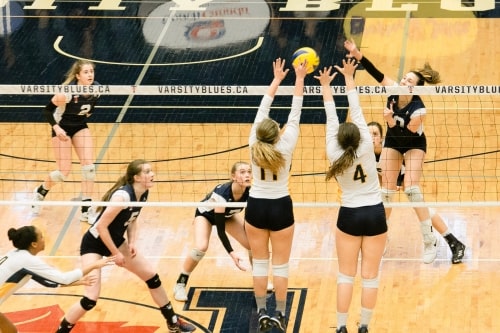Overview of Volleyball Rules

Overview of Volleyball Rules: Introduction to the Basic Rules of Volleyball
Volleyball is one of the most popular and dynamic sports played worldwide, enjoyed by both amateurs and professionals. Its fast paced nature, combined with a clear set of rules, makes it an engaging game for players and spectators alike.
Whether you’re new to volleyball or looking to refresh your knowledge, understanding the basic rules is crucial for appreciating the game fully. This article provides a comprehensive overview of the fundamental rules of volleyball, including court layout, player roles, game mechanics and scoring systems.
The Volleyball Court
A standard volleyball court is rectangular, measuring 18 meters (59 feet) long and 9 meters (29.5 feet) wide. The court is divided into two equal halves by a centerline and a net. The height of the net varies depending on the gender of the players:
- Men’s Volleyball: Net height is 2.43 meters (7 feet 11 5/8 inches).
- Women’s Volleyball: Net height is 2.24 meters (7 feet 4 1/8 inches).
Each side of the court has an attack line, located 3 meters (9 feet 10 inches) from the net, which marks the boundary for back-row players when attacking the ball.
The court is surrounded by a free zone that extends at least 3 meters (9 feet 10 inches) beyond the sidelines and end lines. This space allows players to make plays outside the court boundary.
Teams and Positions
Each volleyball team consists of six players on the court at a time. The players rotate through positions as the game progresses. The standard positions are:
- Outside Hitter (Left-Side Hitter): Primary attacker, often the most versatile player.
- Middle Blocker: Specialized in blocking and attacking from the center.
- Opposite Hitter (Right-Side Hitter): Secondary attacker and blocker.
- Setter: Facilitates offensive plays by setting up attackers.
- Libero: Defensive specialist who wears a different color jersey and cannot attack the ball above the net.
- Defensive Specialist: Similar to the libero, but without the restrictions on attacking.
Players rotate positions clockwise after winning a rally on their serve, ensuring that everyone participates in both the front row and back row.
Starting the Game and Rotations
A volleyball game begins with a coin toss to determine which team serves first. The winning team can choose to either serve or receive the ball.
Players must maintain their rotational positions on the court during the serve. The six positions are designated as follows:
- Three Front-Row Players: Left-front, center-front, right-front.
- Three Back-Row Players: Left-back, center-back, right-back.
Once the ball is served, players can move freely around the court, but they must return to their designated positions for the next serve.
Basic Rules of Play
Volleyball is played by hitting the ball back and forth over the net. Each team is allowed a maximum of three touches to return the ball to the opponent’s side. The basic rules of play include:
- Serving: The game starts with a serve. The server stands behind the end line and must hit the ball over the net into the opponent’s court. The serve can be underhand or overhand.
- Passing: The first touch is often a “pass” or “bump,” where a player uses their forearms to direct the ball to the setter.
- Setting: The second touch is typically a “set,” where a player uses their fingertips to gently push the ball upward for an attacker.
- Attacking (Spiking): The third touch is usually an “attack” or “spike,” where a front-row player jumps and hits the ball forcefully over the net.
- Blocking: Front-row players can attempt to block an opponent’s attack at the net. Only players in the front row are allowed to block.
- Digging: A defensive move where players prevent the ball from hitting the ground by making an acrobatic pass.
Violations and Faults
Certain actions are considered violations or faults, resulting in a point for the opposing team. Common violations include:
- Four Hits: When a team uses more than three touches to return the ball.
- Double Hit: When a player contacts the ball twice in succession (except during a block).
- Lift or Carry: When a player holds, throws, or catches the ball instead of hitting it cleanly.
- Net Violation: Touching the net during play.
- Foot Fault: Stepping on or over the end line while serving.
- Overreach: Interfering with the ball on the opponent’s side of the net.
- Out of Rotation: Players failing to rotate correctly before a serve.
Scoring System
Volleyball uses a rally scoring system, meaning a point is awarded on every rally, regardless of which team served. Matches are typically played as follows:
- Best of 5 Sets: The first team to win 3 sets wins the match.
- Winning a Set: The first team to score 25 points (with a 2 point lead) wins the set.
- Deciding Set (5th Set): If a match goes to a fifth set, it is played to 15 points (with a 2 point lead).
If the ball lands out of bounds, hits the net, or a violation occurs, the opposing team is awarded the point.
Substitutions and Libero Rules
- Substitutions: Teams are allowed a maximum of 6 substitutions per set.
- Libero: The libero can replace any back-row player without counting as a substitution. However, the libero cannot serve (in some leagues, this rule is different) and cannot attack the ball above the net’s height.
Timeouts and Intervals
Each team is allowed two timeouts per set, lasting 30 seconds each. In official international competitions, there are also technical timeouts when the leading team reaches 8 and 16 points.
Conclusion
Understanding the basic rules of volleyball enhances both playing and watching the game. With its clear structure, defined roles and engaging play style, volleyball offers excitement and challenges for all skill levels.
Whether you’re playing recreationally, joining a team, or watching a professional match, knowing these rules ensures you can fully enjoy the fast paced and strategic world of volleyball.


